

Port Arthur historical prison site 'displaying evidence' of damage from sea level rise. Tasmania's World Heritage-listed Port Arthur Historic Site is under threat from climate change, according to the authority responsible for managing the major tourism destination.
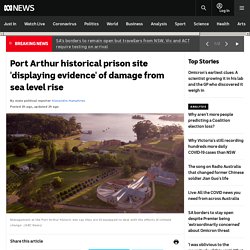
Key points: Port Arthur's Isle of the Dead is believed to be home to the earliest sea level benchmark anywhere in the worldThe British navy marked the sea level on the island in July 1841 as part of tidal surveysThe historical prison's archaeology manager says the colonial-era site is being affected by rising sea levels and increasing salinity Some heritage has already been lost at the Coal Mines Historic Site, also on the Tasman Peninsula, where convicts were once forced to perform hard labour. David Roe, the archaeology manager for the Port Arthur Historic Site Management Authority, revealed to a parliamentary committee that climate change will be one of the "biggest issues" for the site in coming years. Experts say it indicates the tide level has already risen 15 centimetres since 1841. Dr Charles Perkins Prize: Winner says don't let others define who you are. "You can't be Aboriginal, you're too smart for that," Benjamin Wilson was told when he was at school.
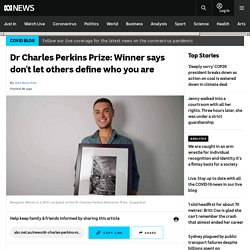
But the 23-year-old Wiradjuri man dismissed those slurs and instead focused on storytelling and learning — which has seen him named a recipient of the Dr Charles Perkins Memorial Prize. "I think that's because I had really strong role modelling from my family and the people around me," he said. One of those strong role models is his 84-year-old grandmother, Elsie Heiss, who instilled in him a love of learning and reading, as well as resilience and a strong work ethic. "At 16, she hopped on the train at Griffith to Shepparton in Victoria, to go and work in a fruit cannery," he said, "that kind of drive has always been in my family". Coin stash discovered at Port Arthur archaeology dig gives rare insight into illicit lives of convicts. Prisoners at historic Port Arthur were not allowed to carry money.
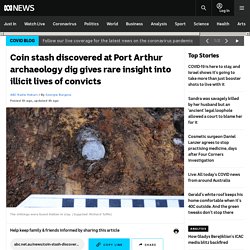
'Tracey's got a secret': Stan Grant and Tracey Holmes open up about their relationship and a surprise twist from the past. I'm sitting opposite Stan Grant in the ABC café in Sydney.
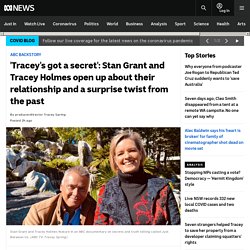
He's agreed to meet for a chat about secrets and truth-telling. I was looking for stories to film for a new documentary series of short stories called Just Between Us. I was sure Stan would have a strong truth-telling story – he's Stan Grant! After tossing a few ideas around, he stopped and looked at me with a raised eyebrow and a sparkle in his eye, as if he'd remembered something good. The Australian families making exciting genealogical discoveries in the age of COVID. Peter McKenna has been researching his family background for close to a decade, and back in 2014 decided to start on his wife Julie’s side of the family.
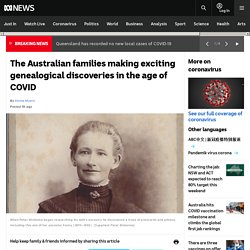
He recently made a timely discovery. Last month McKenna uncovered a bundle of postcards, with one in particular piquing his interest. Written in 1913 by man named Will Morrison, the postcard vividly describes what was occurring in Sydney at the time: the city was in a months-long lockdown. "He was writing to the family up in Grafton and about to go on a voyage to Newcastle, past Sydney. One woman is revealing the stories of convicts, settlers buried on the Isle of the Dead. On a tiny island off Tasmania's historic Port Arthur, lie the bodies of 1,000 people.
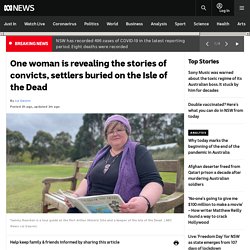
Key points: The Isle of the Dead was the principal burial ground for the Port Arthur penal station between 1833 and 1877Tammy Reardon is researching the family histories of the people buried on the islandA recently completed $1.3-million conservation project will help protect the graves on the island Women, children, soldiers, free settlers, paupers and convicts were all buried on the Isle of the Dead — the principal burial ground for the Port Arthur penal station between 1833 and 1877. While some were given proper gravestones, the burial sites of many convicts were only marked by a piece of wood. Tammy Reardon, a tour guide at the Port Arthur Historic Site and a keeper of the island, has taken it upon herself to delve deeper into the lives of some of the people who ended up there, in an effort to keep their stories alive.
Alice Springs celebrates 100th anniversary of the first ever flight to Central Australia. Aviator Lieutenant Frank Briggs, adventurer Francis Birtles and mechanic Alfred Bailey flew a de Havilland-4 from Port Melbourne to the centre of Australia, landing in Alice Springs on October 5, 1921.
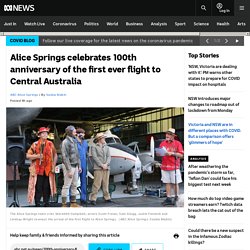
Key points: The de Havilland-4 flew from Port Melbourne to Alice Springs in 10 days. 100 years later, the Central Australian Aviation Museum has celebrated the historic flightOrganiser Franca Frederiksen says she's overjoyed so many young people attended The journey, which today would take less than three hours, extended over 10 days with the crew making multiple stops to refuel along the way. Last Argyle pink diamonds are about to be sold at auction by Rio Tinto. Travelling more than 13,000 kilometres to the richest-known source of pink diamonds in the world wasn't easy.
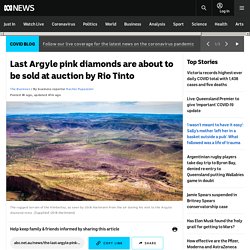
Key points: The 2021 Argyle Pink Diamonds Tender will sell the last of the large pinks to be unearthed from the Kimberley mineOrganisers say 70 pink diamonds will be sold in the silent auctionThat final tender also includes 24 carats of the even rarer Argyle blue and violet diamonds But, for Danish jeweller Ulrik Hartmann, reaching Rio Tinto's Argyle diamond mine in the remote Kimberley region of Western Australia was worth every hour of his two-day journey halfway around the world.
"It was a dream come true," Mr Hartmann said. "This very rough outback in the East Kimberley. Mr Hartmann is one of only about 100 jewellers and diamond traders who are invited to bid for the prized diamonds at the annual Argyle Pink Diamonds Tender. "When we go to the Argyle Pink Diamonds Tender, it's like Christmas Eve for us," Mr Hartmann explained. The new Moonah Hotel is hoping to capitalise on the changing tastes of a booming suburb. More than 80 years ago there was a fierce debate and considerable public interest about whether Moonah, a growing suburb of Hobart, needed a second pub.
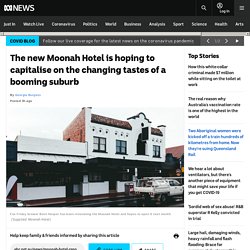
Key points: An art deco pub that was built in 1934 and has been sitting empty has found a new owner and will open again next monthOwner Benn Hooper hopes the new demographics of Moonah will support the pubHobart's northern suburbs have been changing rapidly as house prices boom and the area sees business renewal In 1934, those in favour of an additional watering hole argued the Glenorchy area, and particularly Moonah, was experiencing rapid growth. It went ahead, and The Mercury reported in June of that year that "splendid progress" had been made, with the foundation stone laid.
Vintage car uncovered on romantic Queensland beach walk. A Queensland couple's romantic beach stroll took an unusual twist when they unearthed a vintage car buried in the sand yesterday.
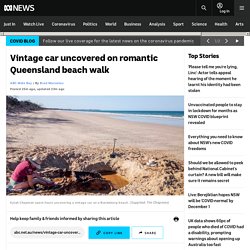
Kylah and Tim Chapman were celebrating their first wedding anniversary with a relaxing walk on Coonarr Beach, south of Bundaberg, when they stumbled upon a small piece of rusty metal. The couple attempted to pick it up but soon realised it wasn't just some small curio. Not many marinas can boast a 100-year-old submarine, but this one does. By the time Australia gets the first of its next fleet of submarines, J-7 will be 113 years old, and won't have sailed anywhere in a century. J-7 may be a familiar sight to dozens of sailors who stride past her every day at Sandringham Yacht Club, but most Melburnians won't even know she's there. Once one of the fastest submarines in the world, the only place she's going these days is deeper into the mud. "She was quite remarkable," the Sandringham Yacht Club's historian Graeme Disney said. So how did this once cutting-edge submarine built for the British Navy end up rusting away next to fancy yachts and speed boats in a marina in Melbourne?
Because everything new eventually becomes obsolete, and then you have to either throw it away or find some other use for it. Inside story: The forgotten game that launched women's football in Australia. "At every level, the story of Australian women's football is one of heartbreak, adversity, and obstacles — so many obstacles — but also of tremendous courage and perseverance. " — Fiona Crawford and Lee McGowan, Never Say Die: The Hundred-Year Overnight Success of Australian Women's Football.
Jean Campbell is standing on the penalty spot. She leans down and carefully places the ball on the hard Queensland turf, balancing and twisting the heavy leather into a boot-scuffed patch of dirt. The 16-year old — her body still growing into itself, still discovering what it can do — stands upright, takes a few steps backwards, and pauses. Her North Brisbane team-mates bustle and bounce a few metres behind her, held back by the invisible line of the 18-yard box, like runners before a race. They're dressed in thick, oversized cotton jerseys and dark red bloomers. Scattered among them are their South Brisbane opponents, kitted out in the same scratchy outfits, but in navy blue. Daylight saving was introduced in WWI to save fuel. Does it still reduce electricity consumption and costs?
In a couple of weeks, Australia's three time zones will become five as daylight saving time kicks in. This means it will be brighter later, especially in southern parts of Australia. At the height of the Hobart summer, for instance, the sun doesn't set until nearly 9pm. And this "longer day" was why daylight saving time was introduced — not just here, but around the world. It was, in essence, a way to save fuel during World War I. With more "usable" hours of daylight, people didn't have to use as much fuel to light up homes and businesses. Research discovery suggests AFL pioneer Tom Wills participated in massacres of Indigenous people. Aboriginal and Torres Strait Islander readers are advised that the following article contains images of people who have died.
A startling discovery by a sports history researcher suggests that AFL pioneer Tom Wills participated in the mass murder of Aboriginal people during the infamous reprisal attacks that followed Queensland's Cullin-la-ringo massacre of 1861. Key points: A Chicago Tribune article from 1895 claims Tom Wills spoke of his participation in reprisals following the Cullin-la-ringo massacreWills is quoted as claiming "we killed all in sight"He also describes murdering an Aboriginal man who stole his jacket. The ghosts are not silent. In the iconic south-west corner of Australia, colonial descendent Sam Carmody set out to uncover long-held family secrets — and discovered terrible acts of settler violence that remain largely unknown and unacknowledged. Grave of Tasmanian women's rights campaigner Jessie Spinks Rooke restored.
Saddlemakers hang up reins after 30 years and more than 3,000 properties. The evolution of Australia's largest lead stack at Mount Isa Mines. Andrew Jones will never forget his first shift as an apprentice at the Mount Isa Mines lead smelter in 1984. "It was very, very dusty, very dirty, hot and sweaty — but a really good atmosphere to work in. " Now a mechanical coordinator in the Bowen Basin coal mines, Mr Jones launched his mining career inside the concrete walls of the famous Mount Isa stack.
How a little red Wikner Ford Special racing car wrote itself into history. When Doug Partington spotted the car of his dreams in pieces under a Brisbane house in 1958 he never imagined it would take him to the most famous racetrack in the world. "They wanted 20 pounds for it," he said. Copperfield store the last building left standing in outback mining ghost town near Clermont. Vase dug up in a garden in Tasmania an 'exceptional' piece of convict pottery. It's 55 years since the Wave Hill walk-off, and Aboriginal workers are still fighting for their stolen wages. From an early age, Yidumduma Bill Harney toiled long, hard days on Northern Territory cattle stations with barely any time off — and he didn't get paid for his work.
Key points: Queensland's iconic Lions Den Hotel up for sale as owner reluctantly eyes retirement. Members of the Gogerly family are buried at the site of their old Booti Booti homestead at Wallis Lake. Tucked away near a popular coastal walking track in northern New South Wales sits a small collection of worn, old grave markers. They have sat among the vegetation for decades, but behind them are remarkable tales of heroism, resilience and bravery.
Researcher and co-founder of MidCoast Stories Janine Roberts noticed the grave markers while out walking on Wallis Lake, near Forster. As Four Corners host, Caroline Jones was a woman breaking new ground. The press called her 'girl' "Girl will take over 4 Corners," the headline screams. It was 1972 and Caroline Jones had been named as the first woman to host the respected program. The press took notice. Why is so little known about the pioneering businesswoman who 'clothed the colonies'? Thornbury homeowners 'blindsided' by blanket heritage protection, hobbling their plans. Century-old outback corner store keeps traditional 'deli' experience alive, thriving in pandemic. George Kennan: How a modest diplomat shaped America's response to Soviet expansion. Rare footage shows rescue of Hollywood’s Jimmy the Chimp on NT's Elcho Island.
Juanita Nielsen's suspected murder brought Arthur King back to Kings Cross after his terrifying ordeal. The history of vegetarianism in Australia is only two centuries old and it's full of characters. Australia once wanted its allies to commit to full employment — what happened? New study reveals history of Aboriginal trade with foreign visitors before British settlement. Bedourie to the border now known as Wangkamahdla country after native title win. From World War II shellings at Bondi Beach to the 1964 Tokyo Olympics — Phil Coles reflects. Fire-ravaged Brunswick Hotel history celebrated as future uncertain. How Mary Ann Campigli, the 'Miss Stayput' of Melbourne, defied her local council to the end. ABC celebrates 75 years of parliamentary broadcasting. This once-booming King Island mining town could have been 'buried' — but longtime residents see a bright future.
No laughing matter: the bizarre colonial project to make WA more European. National Archives of Australia says funding is a 'game-changer' in race to preserve priceless national memories. Thousands of images capturing moments of Australian history up for auction. Previously classified diplomatic cable reveals what PM Bob Hawke thought he knew about the Tiananmen massacre. Holden utes of outback NSW paint tribute to Australia's lost automotive history. The phrase 'dole bludger' emerged in the 1970s, and it's still serving its political purpose. Smithtown Milo factory celebrates 100 years of sweet success. Interactive, 'street-level view' brings colonial Adelaide to life. Blackmans Point massacre of Birpai people could soon be formally acknowledged. Time running out to restore historic Tasmanian steamship Cartela. Melbourne's housing wave has reached Preston Market. Some fear it won't survive. Period-related advertising used to trade in shame and secrecy. How far have we come?
Dame Nellie Melba footage found in Adelaide law firm. From salted pork to Vegemite: a potted history of salt in Australia. Brisbane textile factory under threat as scrap, ghost hunters cotton on to heritage site. 'Brave' Flying Doctor pilot remembered on 40th anniversary of deadliest crash in RFDS history. Soldier settler success story carved out of the rainforest of north Queensland. Historic WA early settler weather journals set to help understand climate change. Bundaberg in focus as indie filmmaker gets hooked on filming Flathead.
'Immigrant town' Caravan holidaymakers from Cairns set to transform Fingal's historic town hall. Lifeboat from sunk 19th century The Maid of Lincoln found in rafters of historic farm shed. Melbourne launching new festival, RISING, to showcase Victorian artists and celebrate city. The little-known story of how this crackpot inventor, liar and murderer escaped the gallows. Australia's largest World War II POW and internment camp marks 80th anniversary. This party invented a type of politics — and deserves greater recognition for it, expert says. Old Errowanbang Woolshed has endured 135 years of history on the land, but its future is in doubt. 75 years since Henry Handel Richardson died, small towns from her childhood keep alive her memory. Australia's first political assassination is just as mysterious today as it was a century ago. Historic organ tells tale of WA shipwreck, settlement and the life of pioneer Sophia Dent.
How the Di Chiera family brought continental food to Perth, changing the local menu forever. Historic 'Locomotive 3801' makes comeback in Sydney after being out of sight for a decade. After the Yoo-rrook Truth and Justice Commission, Aboriginal people are not obliged to forgive. Out of the garage onto the silver screen: Corrick Collection unearths some of Australia's earliest movies. One-man play to honour life of Tasmanian war correspondent Neil Davis. Out of the garage onto the silver screen: Corrick Collection unearths some of Australia's earliest movies. More families of servicemen involved in top-secret WWII Australian mustard gas trials and storage speak out.
Aboriginal artefact reveals ancient art of slow cooking in Indigenous culture. Discovery of ancient Bogong moth remains at Cloggs Cave gives insight into Indigenous food practices. Historical photos of Brisbane in the 1800s brought to life thanks to volunteer restorer - ABC News (Australian Broadcasting Corporation) ASIO spy kid recounts life with secret agent parents and holidays with Cold War defectors. How 'Port Essington Jack' and his brothers were kidnapped and brought to Hong Kong. As workers return to the office, men might finally shed their suits and ties. The bravery, tragedy, and mystery of Captain Smirnov's secret diamond delivery.
Les Everett's epic quest to uncover Australia's 'lost' cricket pitches. Most of Melbourne's slum pockets were demolished, but a few survived - ABC News (Australian Broadcasting Corporation) Tasmania's 150yo Don River Railway plea for funding to survive - ABC News (Australian Broadcasting Corporation) The unexpected rescue mission that inspired ABC mini-series Flight into Hell — and other survivalists. Child's remains lead Tasmania's historians to unearth fate of convict's daughter.
Tasmanian artist Adam Taylor bringing the past back to life with colourised photos. Meet Arnold and Gregory, two vintage collectors who've built their lives around a love of all things 'funky and wild' In the 1990 NT cabinet documents, a cash-strapped government grapples with evergreen issues. Seven things previously secret cabinet documents tell us about the 'last year of normality' in 2000. Historic change to Advance Australia Fair, Australia's national anthem, in the 'spirit of unity' From shanty shelters to luxe lodgings, Tasmania's bush huts have evolved. Rare soldier's diary reveals secret massacre of Indigenous Tasmanians after almost 200 years.
National Library finds 120-year-old chocolates commissioned by Queen Victoria and owned by Banjo Paterson. Corkman Pub demolition developers jailed for contempt of court - ABC News. Holden's finest vehicles, old and new, on display for the first time - ABC News. History for sale as Beaconsfield banks on a mine-lead recovery - ABC News.